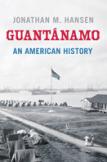Island Paradox
In this well-written and lively account of a place most Americans find thoroughly mysterious, Jonathan M. Hansen, a historian at Harvard University, offers a carefully crafted history of one of America’s most paradoxical possessions, viewed in connection to United States national interest.
As the United States’ “war on terror” morphs into some other configuration, it is the U.S. naval base at Guantánamo Bay, Cuba, that continues to generate legal controversy and debate about America’s human rights record.
Guantánamo Bay held attractive geological and geographic qualities for both its original inhabitants and all those who would come later. Strategically, the bay occupies a position in the Caribbean Basin and in the Western Hemisphere that made it a desirable port from the Age of Exploration through the age of American imperialism.
British Admiral Edward Vernon explained the strategic value of Guantánamo Bay to Lawrence Washington, half-brother of George, who participated in Vernon’s landing there in 1741. For Vernon, Cuba was the “gravitational center” for all trade from the American colonies to Mexico. The geometrical center for all future expansion was Guantá-namo Bay. John Adams, Thomas Jefferson and George Washington all seemed to agree with this original assessment.
During the 19th century, a combination of the “closing of the American frontier” and the rise of U.S. sea power gave greater weight to Guantánamo’s strategic position. The expansionist theories of Admiral Alfred Thayer Mahan energized the search for U.S. naval coaling stations throughout the Caribbean. Expansionism, imperialism and American exceptionalism would merge over the coming decades to forge the special position of Guantánamo Bay in the U.S. political landscape.
The first Marines rushed ashore during the Spanish-American war. Establishing a base, the Americans fought side-by-side with indigenous Cubans, whose aspirations were stoked by shared principles of democracy and autonomy. With the United States firmly in control of Cuba by the end of 1898, American principles were slow to find areas for growth on Cuban soil. The Platt Amendment of 1901 was adopted by the U.S. Congress, but in a puzzling political twist, it was also incorporated into Cuba’s new constitution. As Cuba took pains to create an independent government, the Platt Amendment indicated that the United States would intervene both to preserve Cuban independence and to “maintain a government adequate for the protection of life, property, and liberty.” For Hansen, Platt offered the perfect ploy for the now 110- year U.S. holding-pattern to begin. Hidden in Platt was the cession of Guantánamo Bay to the United States.
Cuban independence in 1903 generated the Cuban-American Treaty, which included the stipulation that the United States would lease Guantánamo Bay as a coaling naval station. “Complete jurisdiction and control” of Guantánamo Bay would be given to the United States, while “the ultimate sovereignty of the Republic of Cuba” remained intact. The Franklin Roosevelt administration annulled the Platt Amendment in 1934, creating a so-called “Permanent Treaty,” which established a definitive leasing arrangement between the United States and Cuba. The hybrid status formulated in Platt remained. A clause indicating that the treaty could be broken only by mutual agreement virtually guaranteed American possession in perpetuity. Since 1959, the Castro government has considered the naval station to be Cuban ground unlawfully occupied by a foreign military.
Hansen’s chronicle of life in Guantánamo is important because as an “American history,” it examines the views of so many Americans who lived in a place where for so long they remained oblivious to the national, cultural, political and ideological wishes of the host country. The author pays close attention to issues of race, mores, cultural conflict and U.S. naval culture. In many cases, he explains, it was the geography of Guantánamo that heightened problems already present.
While important as a fueling outpost, Guantánamo’s strategic role during the 1940s and through the cold war began to diminish. Geopolitics was shifting from South America to Southeast Asia—and then back-flipping toward Europe as the 1980s and 1990s wore on. Historically, the author points out, alcoholism flourished at Guantánamo, prostitution was rife (Navy men routinely referred to the base as Gitmo), while race relations were always problematic. Since the 1930s, placement at the base was considered a career-ender for any ambitious admiral.
Much of this changed as the United States embarked upon its global war on terror. Paradoxically, high government officials in the Bush administration initially spurned Guantánamo Bay as a possible place of detention for Al Qaeda and Taliban enemy combatants. But over time, Guantánamo Bay’s hybrid status made it perhaps the shrewdest choice for an administration geared to set new and troubling directions for its foreign and human rights policies. As Hansen shows, the cages of Camp X-Ray had their precedents in previous brigs, detention centers and prisons that dotted the history of this mysterious 45-square-mile compound.
During the Cuban missile crisis, Admiral Robert Dennison once described Guantánamo’s strategic topography as “undefended and indefensible…a coastal pocket with Cuban hills looking down.” The U.S. naval station’s newest legacy as an infamous place of “enhanced interrogation techniques” underscores Hansen’s “American history” of Guantánamo as a forced history, one largely unwanted by its host, and one that many Americans find increasingly indefensible.
This article also appeared in print, under the headline “Island Paradox,” in the November 7, 2011, issue.








